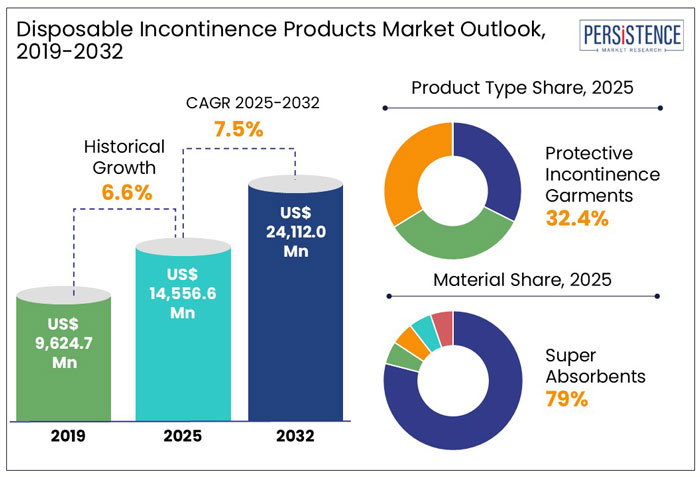Industry: Healthcare
Published Date: March-2025
Format: PPT*, PDF, EXCEL
Delivery Timelines: Contact Sales
Number of Pages: 204
Report ID: PMRREP11518
The global disposable incontinence products market size is anticipated to reach a value of US$ 14,556.6 Mn in 2025 and is set to witness a CAGR of 7.5% from 2025 to 2032. The market will likely attain a value of US$ 24,113.0 Mn in 2032.
The Disposable Incontinence Products Market is experiencing significant growth, driven by the aging population, increasing prevalence of urinary incontinence, and rising awareness about personal hygiene. Advances in superabsorbent polymers and skin-friendly materials are enhancing product comfort and performance, fueling demand. Additionally, the expansion of e-commerce and home healthcare services is making incontinence products more accessible. Sustainability trends are also shaping the market, with manufacturers focusing on biodegradable and eco-friendly alternatives. Moreover, premiumization and gender-specific incontinence products are gaining traction, particularly in developed markets, as consumers seek more discreet and comfortable solutions for managing incontinence effectively.

Key Highlights of the Disposable Incontinence Products Industry
| Attribute | Key Insights |
|
Disposable Incontinence Products Market Size (2025E) |
US$ 14,556.6 Mn |
| Market Value Forecast (2032F) | US$ 24,113.0 Mn |
| Projected Growth (CAGR 2025 to 2032) | 7.5% |
| Historical Market Growth (CAGR 2019 to 2024) | 6.6% |
Evolution and Growth Drivers
In the historical period from 2019 to 2024, the global disposable incontinence products industry witnessed a CAGR of 6.6%.
The Disposable Incontinence Products Market has grown steadily, driven by aging populations, rising awareness, and innovations like ultra-thin, absorbent materials. North America and Europe led growth due to strong healthcare systems. Gender-specific, eco-friendly options and demand for home healthcare fueled adoption, while advanced technologies enhanced product performance and market expansion.
Trend and Rising Demand of Disposable Incontinence Products Market
From 2025 to 2032, the disposable incontinence products industry is likely to showcase a CAGR of 7.5%.
The Disposable Incontinence Products Market is set for strong growth, driven by aging populations, rising incontinence cases, and product advancements. Asia-Pacific leads expansion, while sustainability trends boost biodegradable materials. E-commerce, reimbursement policies, and smart sensors enhance accessibility and convenience, pushing manufacturers toward high-performance, discreet, and eco-friendly solutions.
Growth Drivers
Increased Adoption of Disposable Incontinence Products
The increased adoption of Disposable Incontinence Products due to increased awareness about personal care and hygiene is driving the market growth. The increasing number of patients suffering from diarrhea, bowel disorders, and nerve damage leading to fecal incontinence also contributes to the increased adoption of disposable incontinence products.
Furthermore, the comfort provided by the ease of wear and disposal, as well as the cost-effectiveness of various Disposable Incontinence Products such as protective incontinence garments and adult diapers, are driving the market growth.
Market Restraining Factors
Reluctance to Adopt Incontinence Products
There is a psychological and social stigma associated with incontinence, which often prevents individuals from seeking medical advice or using appropriate products. As bladder control and capacity decline with age, many individuals experience frequent urination and incontinence issues. However, embarrassment, cultural taboos, and lack of awareness discourage open discussions with healthcare professionals. This reluctance leads to underdiagnosis and low product adoption, particularly in developing regions where awareness campaigns are limited. Additionally, concerns about dignity and self-image may result in delayed use of incontinence products, impacting market growth despite rising demand.
Key Market Opportunities
Sustainability and Biodegradable Products possess Growing Opportunity in the Disposable Incontinence Products Market
The demand for sustainable and biodegradable disposable incontinence products is rising as consumers prioritize eco-friendly alternatives. Traditional incontinence products contribute to plastic waste, prompting manufacturers to develop biodegradable materials, plant-based fibers, and recyclable packaging. Government regulations supporting sustainability and increasing consumer awareness drive market growth. Companies investing in compostable and flushable solutions can gain a competitive edge while reducing environmental impact.
Sustainability in disposable incontinence products offers a major growth opportunity. Innovating with biodegradable materials and eco-friendly solutions enhances market reach, reduces environmental impact, and meets rising consumer and regulatory demands.
Product Insights
Protective Incontinence Garments: Leading the Market with Comfort, Convenience, and Innovation
Protective Incontinence Garments segment is projected to hold 32.4% share of the global market in 2025. It is anticipated to continue to lead the disposable incontinence products market due to their widespread consumer preference, ease of use, and broad applicability. Unlike urinary catheters and urine bags, which are primarily used for severe incontinence and require medical supervision, protective garments such as adult diapers and disposable underwear offer comfort, discretion, and convenience for individuals with mild to moderate conditions. Continuous innovations, including ultra-absorbent materials and odor control, have enhanced product appeal.
Protective incontinence garments dominate the market due to affordability, ease of use, and innovation. Growing awareness and acceptance ensure their continued leadership, providing comfort, discretion, and improved quality of life for users.
Application Insights
Super Absorbent Polymers: Leading and Fastest-Growing Segment
Super Absorbents segment is projected to hold 78.7% share of the global market in 2025. Super absorbent polymers (SAPs) lead the disposable incontinence products market due to their exceptional liquid absorption and retention capabilities, which significantly enhance product performance. Unlike cotton fibers or fabrics, which have limited absorbency, SAPs can absorb hundreds of times their weight in liquid, keeping the surface dry and preventing leakage.
Super absorbent polymers are also fastest growing due to their high absorption, leakage protection, odor control, and comfort. Their cost-effectiveness, slim design, and rising demand for discreet, high-performance incontinence products further drive market expansion.

North America Disposable Incontinence Products Market
North America Dominates the Disposable Incontinence Products Market with Strong Growth Prospects
North America leads the disposable incontinence products market with 35.6% of share in 2025, due to its aging population, high healthcare expenditure, and strong awareness regarding incontinence management. The region's advanced healthcare infrastructure supports the widespread adoption of premium products like adult diapers, pads, and underpads.
An older population, more awareness of incontinence, desire for high-end products, inflation-driven pricing, better reimbursement practices, and developments in absorbent technologies are all contributing factors to the growth of the disposable incontinence market in the United States.
Europe Disposable Incontinence Products Market
Europe Emerges as the Fastest-Growing Region
Europe is the fastest-growing region in the Disposable Incontinence Products Market with 28.4% share in 2025, due to its rapidly aging population, increasing awareness of incontinence care, and strong government support. Countries like Germany, France, and the UK have well-established healthcare reimbursement systems, making premium incontinence products more accessible.
Innovation in product creation is also fueled by growing consumer preference for high-absorbency and environmentally friendly solutions. Manufacturers are further encouraged to develop cutting-edge, skin-friendly, and biodegradable products by the region's stringent hygiene and environmental requirements. The European market is increasing at a faster rate due to a growing senior population and ongoing investments in healthcare infrastructure.
Asia Pacific Disposable Incontinence Products Market
Asia-Pacific Drives Rapid Growth Strong Demand and Policy Support
The Asia-Pacific region is experiencing rapid growth in the Disposable Incontinence Products Market due to its elderly population, awareness, and improving healthcare infrastructure. Countries like China, Japan, and India are seeing rising demand for affordable yet high-quality incontinence solutions.
Urbanization, rising disposable incomes, and lifestyle changes are driving consumer preference for premium and eco-friendly products. China's tariff-free policies on certain healthcare products make imports more accessible, further boosting market expansion.
With advancements in product innovation and a shift toward sustainable materials, the Asia-Pacific market is poised for continued strong growth.
The disposable incontinence products market is moderately competitive due to the presence of small and large market players who offer a range of implants for breast augmentation, reconstruction, or other cosmetic procedures. The market players are actively involved in enhancing their offering to increase their market share.
Key Industry Developments
|
Report Attributes |
Details |
|
Historical Data/Actuals |
2019 - 2024 |
|
Forecast Period |
2025 - 2032 |
|
Market Analysis Units |
Value: US$ Bn/Mn, Volume: As applicable |
|
Geographical Coverage |
|
|
Segmental Coverage |
|
|
Competitive Analysis |
|
|
Report Highlights |
|
|
Customization and Pricing |
Available upon request |
Disposable Incontinence Products Market By Material
Disposable Incontinence Products Market By Product Type
Disposable Incontinence Products Market By Distribution Channel
Disposable Incontinence Products Market By Regio
To know more about delivery timeline for this report Contact Sales

The global Disposable Incontinence Products Market is estimated to increase from US$ 14,556.6 Mn in 2025 to US$ 24,113.0 Mn in 2032.
The Global Disposable Incontinence Products Market is being propelled by Rising aging population, increasing awareness, product innovations, eco-friendly solutions, government support, and expanding online retail drive market growth.
The market is projected to record a CAGR of 7.5% during the forecast period from 2025 to 2032.
Major players include Becton, Dickinson and Company, ConvaTec Inc., PAUL HARTMANN AG, Unicharm Corporation, Kimberly-Clark Corporation, B. Braun Melsungen AG, Medline Industries, Inc., Others.
Opportunities include Growing Aging Population, Eco-Friendly & Biodegradable Products, Healthcare & Institutional Demand.